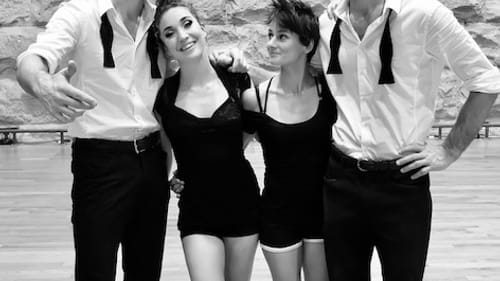Stay in the Loop
BSR publishes on a weekly schedule, with an email newsletter every Wednesday and Thursday morning. There’s no paywall, and subscribing is always free.
Circus of tomorrow
FringeArts presents Barcode Circus Company's 'Sweat and Ink'

Fringe Arts and Circadium School of Contemporary Circus hosted a festival of circus arts last weekend. Featured performers included Circadium artists, local favorites Almanac Dance Circus Theatre, and Montreal-based troupe Barcode.
Although you’ll still see death-defying leaps and the girl on the flying trapeze, contemporary circus is very different from its origins in the big top. The evolution began in the 1970s with circuses that featured human but not animal performance, such as Cirque du Soleil. Now, smaller troupes whose work includes more storytelling elements represent the next iteration of the form. Members of Barcode performed with another Montreal circus troupe, 7 Fingers, in the 2012 Philadelphia Curated Fringe show Sequence 8.
Search for meaning
Because contemporary circus is so new, there are no expectations about how to experience it. That can make watching it both very exciting and a little frustrating.
Sweat and Ink, Barcode’s contribution to the festival, marks the company’s first full-length show (it's about two hours). It’s described by the company as “an exploration of memory, of identity; a reflection on how we remember and the ways we capture what exists only deep within ourselves: through images, words, and physical expression. It is a celebration of imperfection, a tribute to how we navigate and interpret these experiences and how they influence us to reevaluate our pasts and shape our futures,” which is saying a lot and therefore not much at all.
Some of the show’s vignettes touch on memory, as when Alexandra Royer talks about where she got the scars on her body. Other moments explore identity, as when performers slap Post-It Notes on one another and shout out labels: “Arrogant!” “Short!” “French!”
Because the show is billed as reflecting certain ideas, its audiences may look for meaning in everything. Sometimes the relationship between a theme and the acts are clear, as in Eric Bates’s stunning juggling routine, which is also about a man juggling conflicting memories of his ex.
Bates breaks the rules of gravity and evokes true wonder as he tosses, catches, and suspends the “memories” in the air. When it’s not so clear, though, all you see is an incredible circus act, which puts you in the strange position of being disappointed by an incredible circus act.

Fact vs. fiction
Sweat and Ink also has a narrative of sorts. There are two couples: one has recently broken up and the other is fighting. The plot is spare on details and relies heavily on the idea that the kinds of conflicts that occur within heterosexual relationships are universal experiences.
Because the performers are talked about as characters, we experience them as characters in romantic relationships. That means a flying leap into someone’s waiting arms becomes a story about love and trust. We now view all their physical interactions as part of the story of that relationship, which makes a hoop routine in which Bates manipulates Royer’s body uncomfortable to watch.
One of the show’s most successful theatrical elements happens when performers step up to a microphone to enter memories — represented by cigar boxes — into an electronic database. “Eric” begins entering memories like how cute “Alex” is when she eats a banana, and ends up writing a rage-filled treatise on why she’s a monster.
More disturbingly, “Eve” (Eve Biegel), whose physical routines with Tristan Nielson include being thrown, dragged, and dropped, only steps to the microphone once, to say “I pushed Tristan too far, but now we’re doing okay again.”
If Barcode — and, by extension, the circus form — is going to use narrative, it must use it responsibly. This means being intentional about the story it tells. Right now, Sweat and Ink is much more about abusive relationships than about memory or identity.
Because of that story, there’s a frustrating gap between the sheer power of the female performers and their narrative selves. Royer is a stunning athlete, but “Alex” is mostly seen through the eyes of her ex. As a result, in the context of the story, her exquisite artistry becomes nothing more than how a man remembers her.
Make no mistake, these are award-winning performers who are among the best at their craft. It is more than enough to watch them do that work. These kinds of boundary-pushing feats come with their own narrative, which is the power of human possibility and held-breath moments between when someone might fall and when, against all odds, they land.
Very much in the spirit of their art, Barcode’s performers attempt to take something that is already amazing and push it to the next level. Marrying the mastery of their skills to storytelling is a worthy goal, and it's exciting to watch them find their way.
What, When, Where
Sweat and Ink. By Barcode Circus Company, dramatic skeleton and staging by Jean-Paul Cloutier. Saturday, June 3, 2018, at FringeArts, 140 N. Christopher Columbus Boulevard, Philadelphia. (215) 413-9006 or fringearts.com.
Sign up for our newsletter
All of the week's new articles, all in one place. Sign up for the free weekly BSR newsletters, and don't miss a conversation.

 Cara Blouin
Cara Blouin